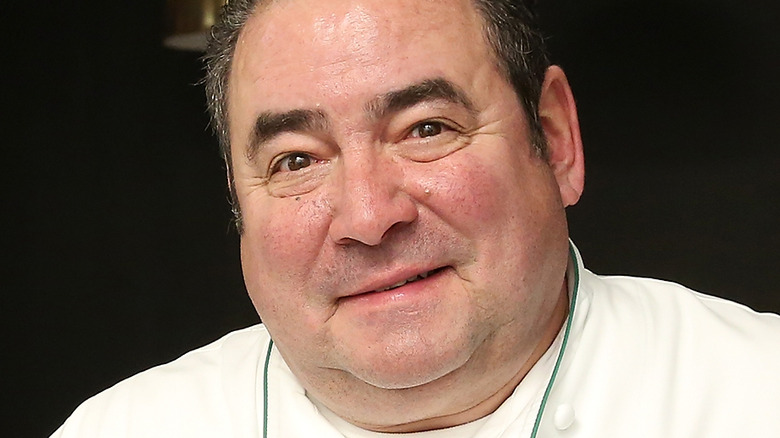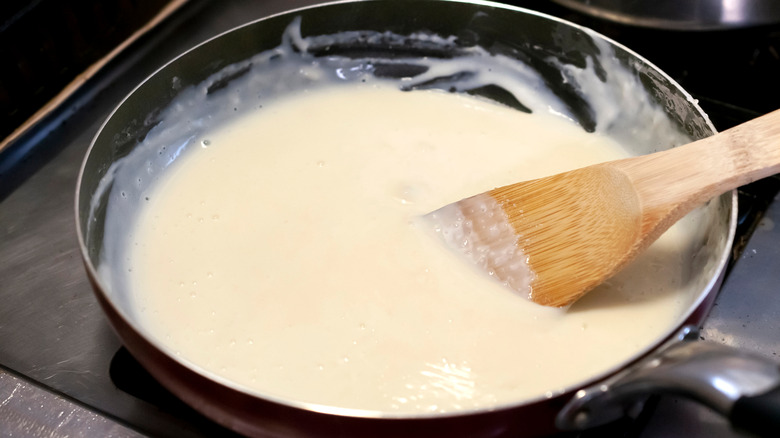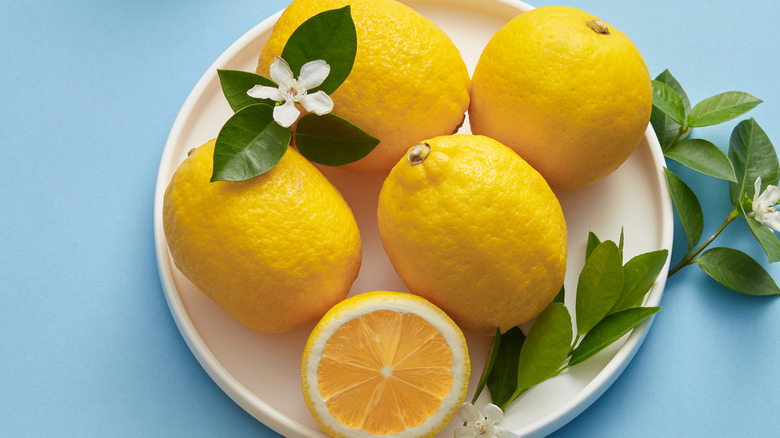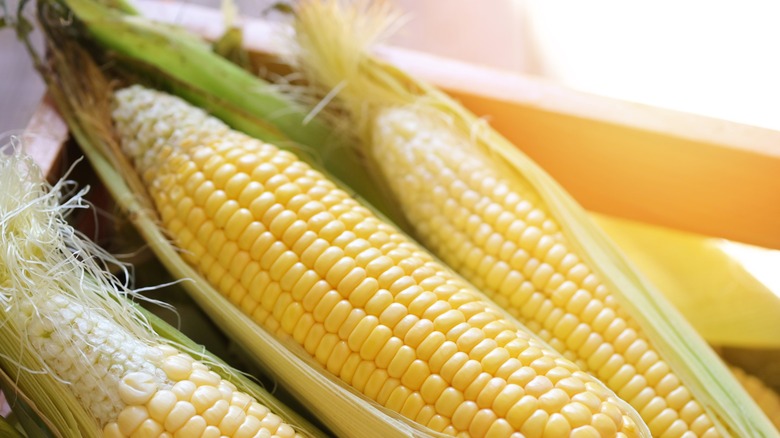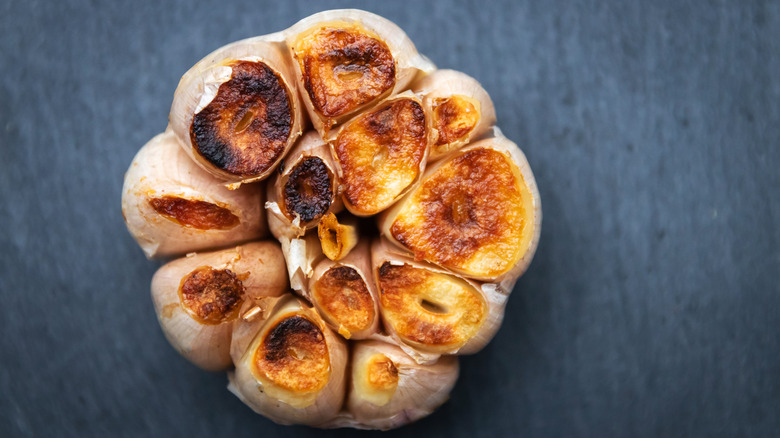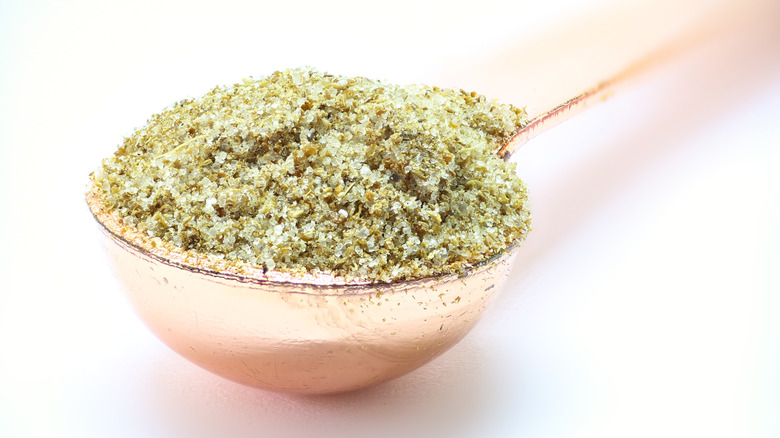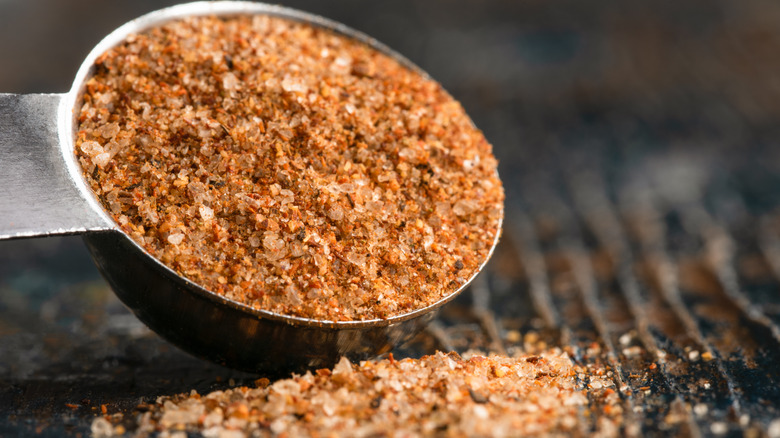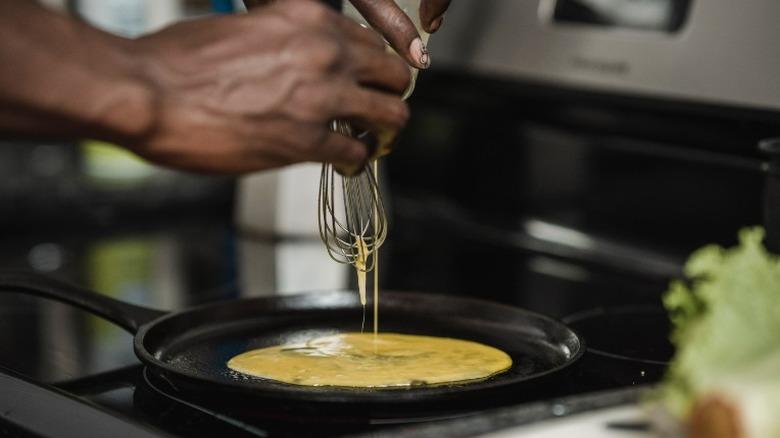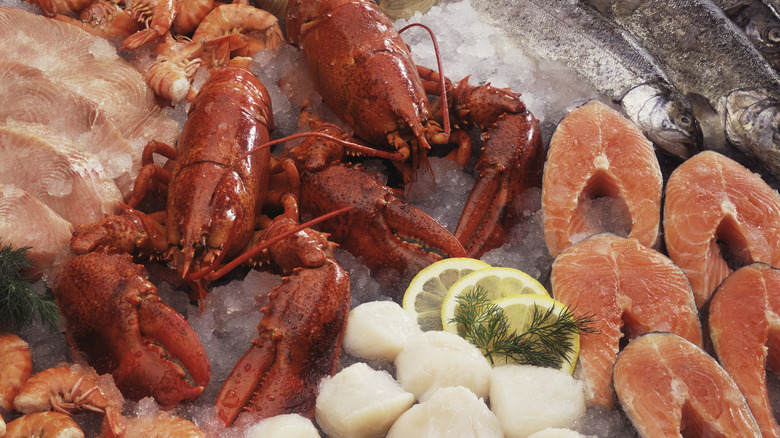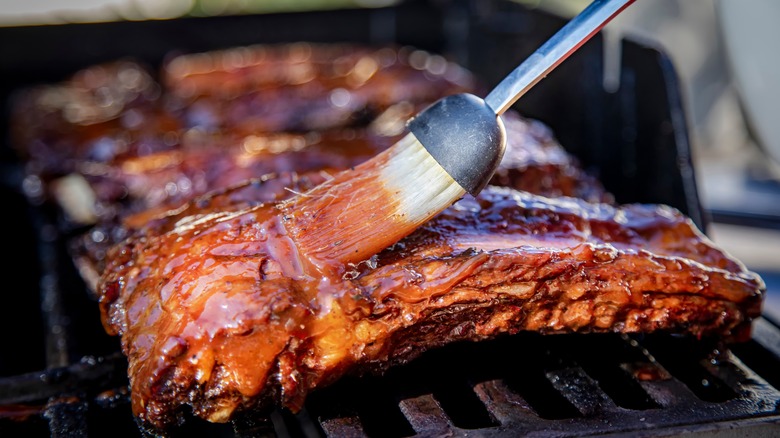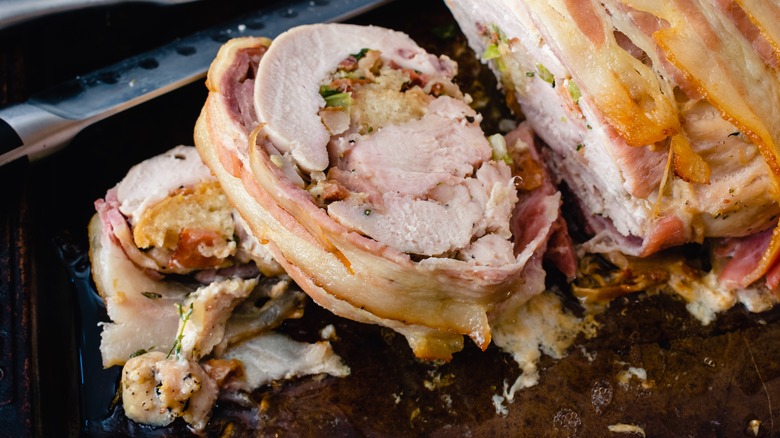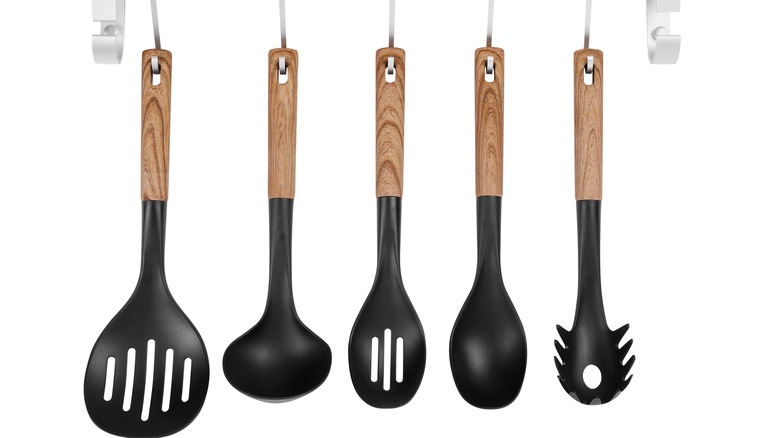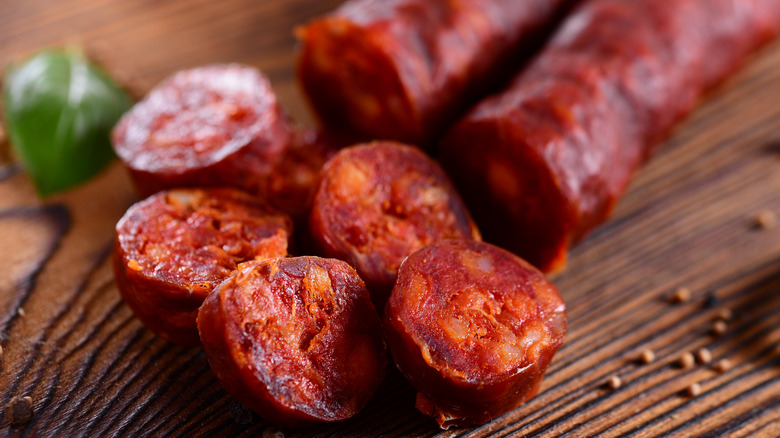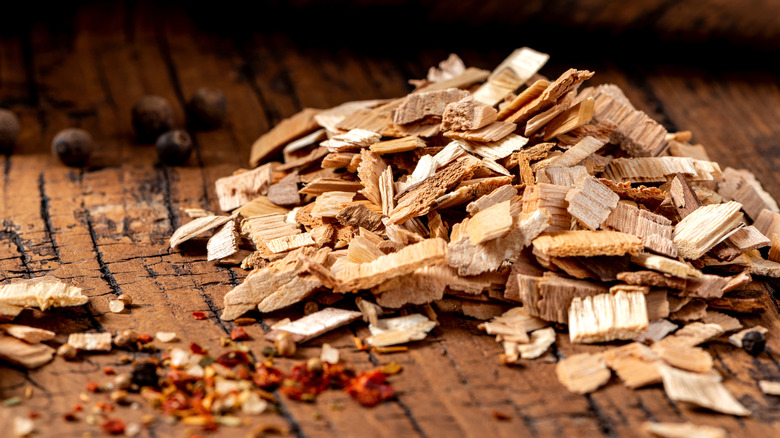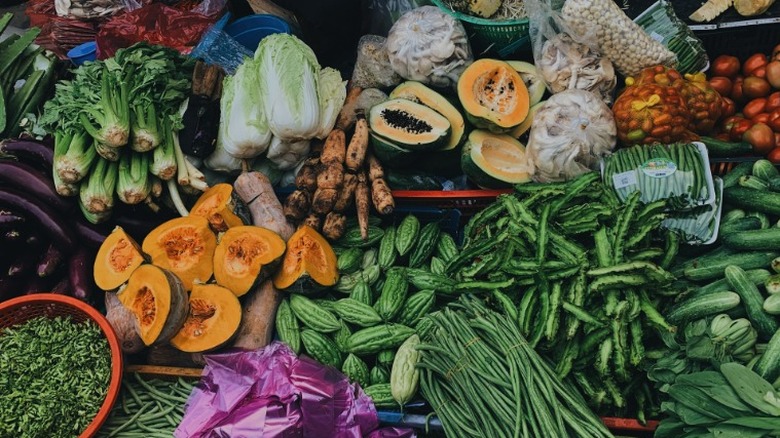BAM! 14 Of The Best Cooking Tips From Emeril Lagasse
We may receive a commission on purchases made from links.
You'd be hard-pressed to find someone who hasn't heard of Emeril Lagasse. The BAM! made him famous, and his recipes made him a household name. Lagasse was primarily responsible for the early success of the Food Network channel in the nineties. And though his star may have dimmed a bit in the age of streaming, he is still well-known among both the young and old, especially since his son has picked up the reins and carried on the Lagasse cooking tradition.
The Fall River, Massachusetts native fell in love with cooking at a young age and turned down a prestigious music scholarship to pursue his dreams at Johnson and Wales. According to the Emeril Lagasse Foundation, he has opened 20 restaurants nationwide, hosted over 2,000 shows on Food Network, and written 19 cookbooks throughout his 31-year career. He even started a foundation that helps youths achieve their dreams through the culinary arts.
Over the years, Lagasse has developed tips and tricks that home chefs can use to kick things up a notch in their own kitchens. Below, we'll walk you through some of his most famous and influential advice.
1. Use a wooden spoon and the right amount of heat in a roux
Rouxs are one of the easiest things to get wrong, especially when you're first learning to cook. In fact, rouxs can still be challenging even for those with a little more experience. There are a few simple tips that will make this task easier and help you whip up a great roux.
A roux is essentially a mixture of flour and fat — typically butter — used to add flavor and texture to sauces, stews, and soups. Cajun or creole style cooking, the type that Lagasse is best known for, uses cooking oil instead of butter because of its higher smoke point. This allows you to cook a classic French version, which is a darker roux that will be more flavorful than white or blonde versions.
Light roux is ideal for delicate soups and pasta dishes. It's also the easiest to make because the longer you cook your roux, the more opportunity there is for error. Lagasse explains you need to start over medium-high heat so it doesn't burn. Start with your fat, then add flour in small doses. And always use a wooden spoon instead of a whisk. Metal tools conduct heat and can cause your roux to overheat.
2. Add acidic lemon to your sauces
Lagasse knows that lemon helps to bring out the flavor in all sorts of different foods, from meats to sweets. Lemons are often the secret ingredient that creates the best and boldest version of any item you're preparing. Lagasse particularly likes lemon juice on cauliflower and also recommends adding garlic, olive oil, salt, and pepper before roasting the veggies in the oven.
Adding lemon juice or zest to your food can completely alter its flavor profile. Lemons work like salt, relying on very few of your senses to be recognized and appreciated. And they both increase salivation, literally making your food more mouthwatering. Citrus juice will brighten and enhance the flavors already in your recipes, mainly when using fruits and vegetables.
When choosing the best lemons for your recipes, look for firm and bright yellow ones with smooth skin. They should be hefty and look exactly like a lemon is supposed to — the way you would expect a picture-perfect one to appear. It may sound obvious, but the closer your lemon is to the ideal, the likelier it is to be juicy, and that juice contributes significantly to your cooking.
3. Soak your corn in salt water
Looking to create the tastiest, moistest corn on your grill this summer? Lagasse suggests you should always soak corn you plan to grill "in a sink full of cold water for hours" before lighting up the barbecue (via People on YouTube). But according to Lagasse, there's more that you can do to get the best moisture and flavor out of your corn soak.
Lagasse recommends adding one simple ingredient to the water: Salt. Think of this like preparing pasta. You want the water you soak your corn in to be as salty as the ocean. You should leave the corn in for a minimum of 30 minutes, but Lagasse recommends that the soak last at least a couple of hours.
You might wonder how this helps your corn. First, it saturates the husks, which keeps them from incinerating over your grill's coals or gas heat. But it's essential for the flavor of your corn, too. Soaking in cold saltwater keeps the kernels juicy while they stay on the grill long enough to develop a delightful, roasted flavor.
4. Add roasted garlic for the perfect seasoning
Lagasse would tell you there are dozens of ways to use "gaahlic" in your recipes, and everyone will make your food taste even more delicious. But Lagasse's favorite preparation for garlic is roasting.
You don't need to season garlic when you roast it, but if you want to follow Lagasse's recipe, you should sprinkle on some of his essence spice before it goes into the oven. Make a foil tent around your garlic bulb and season it with oil, salt, and pepper, then let it roast in the oven for about 40 minutes.
Roasted garlic has a more tempered flavor than the raw variety, and it keeps surprisingly long for a cooked vegetable — two to three days whole, or up to a week if you've mashed it into a paste. In fact, Lagasse likes using garlic paste so much that he has his own recipe for that, too. It uses four dozen garlic cloves, oil, salt, and pepper. Since you're using cloves and not a full bulb here, the roast should only take about 20 minutes. Once it's done, remove the seasoned garlic from the oven and purée with olive oil in a mini food processor.
5. Use celery salt in everything
According to Restaurant Hospitality, Lagasse listed celery salt as one of the things he couldn't live without. The chef explains, "I use it in almost everything. People don't usually guess that it's in there, but I can tell you that it adds oomph to many dishes. My test kitchen team was very surprised when I shared this secret with them." Considering Lagasse swears by celery salt, this unique seasoning could be just what you need to kick things up a notch in your own kitchen.
You could learn to make celery salt at home instead of buying it bottled at the store. Two different methods exist for making this seasoning salt at home. The first combines ground celery seeds and salt. The second method uses dried celery leaves and salt for a slightly more do-it-yourself version.
This can be an excellent way to use the leaves from the celery you bought without wasting anything. If you go this route, you'll need to dry the leaves first, grind them up, and then mix them with salt. You'll need one-part dried celery leaves and two parts fine sea salt or table salt.
6. Add spice with creole seasoning
There are many spices that Lagasse uses regularly, but this one is his favorite seasoning. It's his own invention, and you can buy it prepackaged or make it yourself. He explained that it's made with "paprika, salt, pepper, garlic powder, onion powder, oregano, thyme, and a little cayenne for a kick to the palette." Like his equally famous "Bam!" expression, this blend of spices was designed to wake people up and enliven the environment and your meal. Even when a recipe simply calls for salt, you could combine two of Lagasse's tips and try using celery salt in this blend for something even more special.
It would be easy to confuse it with Cajun seasoning, but they are different. The primary difference is that creole seasoning contains herbs, while Emeril's Cajun seasoning is just spices. And while there are plenty of things you can use either of these blends with, there are some places where they are necessities. Lagasse explains that creole seasoning is an essential part of his gumbo recipe.
7. Make your scrambled eggs the right way
It is true that every pro chef has a scrambled egg recipe. What's the secret to Lagasse's scrumptious scrambles? Unlike his roux, he recommends using a whisk when making scrambled eggs.
Whisk them well before they go into the pan and stir them at just the right moment once they're in the pan. It's easy to do it too early or too late. Once they're cooked, you should serve them on a heated plate, so you don't sacrifice any flavor to your surrounding atmosphere.
Lagasse uses unsalted butter in the pan and whisks the eggs with whole milk. He also adds shredded cheddar and Baby Bam, a version of his creole seasoning with less salt and spice. If you add cheese and spices to your eggs, Lagasse recommends stirring continuously and only cooking for about 30 seconds. As with the traditional variety, this will retain the best flavor if you serve them on a hot plate. The taste and texture of your eggs will start to change as they cool.
8. Let seafood come to room temp before you grill
Certain types of fish and most fresh seafood are expensive. So, it stands to reason that people want to keep them in the fridge to stay as fresh as possible before putting them on the grill. But Lagasse warns home chefs not to do this because it will cause those expensive items to stick to your grill. This will ruin your meal and leave you with a big cleanup.
Lagasse explained that you should always take fish and seafood out for at least 30 minutes before putting them on the grill. He advises that, when you're grilling, fish and other seafood should be at room temperature before they go on the grill. But that isn't Lagasse's only tip when cooking summer seafood on your patio.
According to the renowned chef, you should also cool down your grill. Once your charcoal is heated, let it chill, and let yourself do the same before putting that fish on the grill. And let it actually cook once it's on the grill instead of constantly checking it and flipping it.
9. Add your sweet sauces in the last 5 minutes of cooking
On his Twitter account, Lagasse reminds people not to add sweet sauces to the food they're grilling until the end to prevent it from charring. Any sauce with high sugar content is prone to burn, so save those sauces for the last five minutes of your cooking time.
You should never add barbecue sauces more than 30 minutes before the end of your cooking time, and it's best to save it for the very end. A good rule of thumb is to use it just long enough to allow it to heat through and caramelize to the meat's exterior. Another tip for barbecue sauces is not to use them too heavily. Brush meat lightly, using only one or two coats of sauce, and never more than ¾ of a cup per side of meat. It also helps to heat your barbeque sauce before applying it to your fish or meat. This enables it to adhere to the surface of the meat.
10. Try turkey roulade instead of stuffing
Instead of stressing out about cooking a whole turkey for the holidays, Lagasse has a suggestion. Just use what people like the most about the meal and create a turkey roulade instead. It's just as delicious (if not more so) and cooks up in a fraction of the time.
It's also an excellent way to avoid having your turkey turn out dry. Lagasse explains this most often happens because people try to cook the breast and legs of the turkey at the same time. Making a turkey roulade eliminates that problem because you only cook the breast. But it does take a bit of preparation.
You'll need to pound the turkey breast first, then slather whatever type of dressing you feel like making on top and roll the breast into a log shape. Tie it to keep it from coming apart in the oven as it cooks. Sear it in a cast iron pan. To kick it up a notch, try wrapping it in bacon before you put it in the oven.
11. Have the right tools on hand
Another trick Lagasse swears by is having the right tool for the job, no matter what that job is. According to ABC News, one of the most important items you can invest in for your kitchen is an instant-read thermometer. This is particularly important for grilling when it can be more challenging to tell the food you're cooking is done.
Other items you should invest in include long-handled spatulas, tongs, and a brush with natural bristles. Synthetic ones are trendy but don't hold up well and could melt if exposed to excess heat. Plastic spray bottles of water next to the grill can also help prevent flare-ups. Towels and rags to grease the grates also help, and you should have brushes to clean them off with once you finish cooking.
Always try to clean the grates when they are still hot, as removing stuck-on food is more manageable. Let them cool until they can be handled, and then use a wire brush to scrub them clean.
12. Add chorizo to your box of homemade stuffing
If you're looking for a way to spice up your stuffing, Lagasse has a recipe for that. He recommends adding chorizo to the usual suspects to make a zesty version of your favorite poultry filler. This isn't particularly surprising since Lagasse's mother was Portuguese, and he discovered his love for cooking in a Portuguese bakery as a teenager.
Masterclass explains that chorizo is a spiced, smoked pork sausage believed to have originated in the Iberian peninsula. It comes in 7 Spanish varieties: Soft, semicurado, curado, riojano, castellano, navarra, and andaluz. It is also available in Mexican chorizo and chorizo verde, which need to be cooked before eating, unlike the Spanish versions.
Portuguese chorizo is similar to the Spanish varieties, and chaurice is a spicy sausage similar to Spanish chorizo used in Cajun and creole cooking. Adding this to your stuffing can give it some much-needed flavor and make it feel like Lagasse might be coming to dinner.
13. Add smoky flavor to your grilled meats
A smoky flavor is a delightful addition to any food you cook on the grill. And it's a pretty easy flavor to add. You can add wood chops if you're cooking on a charcoal grill. Ensure you soak them before adding them to the heat, so they don't catch fire.
You'll need more prep if you use them on a gas grill. There are attachments you can use to add wood chips, or you can use a foil pack. If you don't have a wood chip attachment for your gas grill, try wrapping your wood chips in foil and poking holes in it.
And it isn't just a smoky flavor you can add using wood chips. You can get different flavors from different types of wood. Consider pecan, hickory, cherry, mesquite, oak, peach, or apple. Hickory is the most common and provides a sweet and smoky flavor. Mesquite is earthy and common in barbecue, while apple is light and works well with light meats, like fish and chicken.
14. Select what is in season
If you're looking for inspiration for tonight's dinner, Lagasse suggests to Senior Life FYI that home chefs should "cook with the seasons and start with ingredients that are at their peak." If you have a daily or weekly farmer's market near you, check out what's in season and what looks good. It might spark an idea for a meal while you're there.
He also recommends keeping things on hand that you can use to quickly put a meal together on short notice or if you don't have time to make a trip to the store. Consider things like pasta, pancetta or bacon, frozen peas, eggs, parmesan, or other types of cheese.
And when you have some time, make stock and put it away to use later. These take some time to put together but little effort. If you work during the week, consider making stock on the weekend. Then freeze them in small quantities to use later in soups, sauces, pasta, and stews throughout the week.
